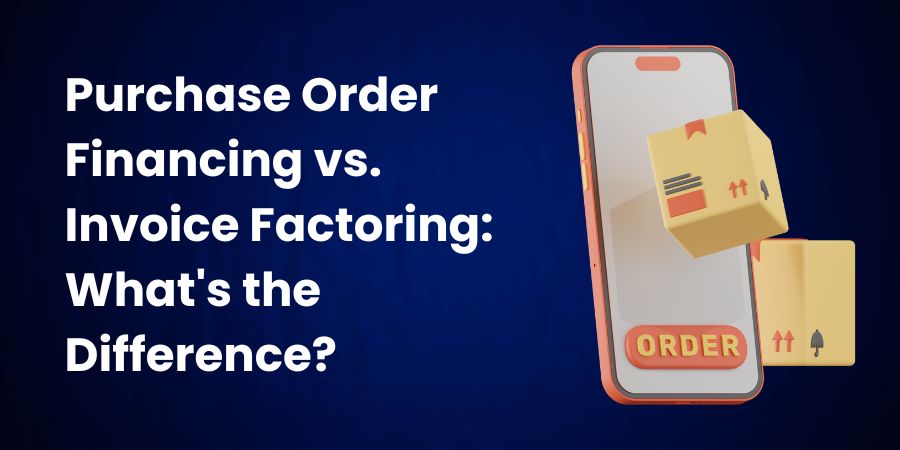If you’re a business owner looking for financing options, you may have come across purchase order financing and invoice factoring. While both can provide cash flow for your business, they have different structures and requirements. This guide will help you understand the differences between the two and determine which option is best for your business needs.
Understanding Purchase Order Financing
Purchase order financing is a type of funding that helps businesses fulfill customer orders by providing the necessary funds to pay suppliers for the goods or services needed to complete the order. This type of financing is typically used by businesses that have large orders but don’t have the cash flow to pay for the supplies upfront. With purchase order financing, the lender pays the supplier directly, and the business repays the lender once the customer pays for the order.
Understanding Invoice Factoring
Invoice factoring is a financing option that allows businesses to sell their outstanding invoices to a third-party company, known as a factor, in exchange for immediate cash. The factor then collects payment from the customers on the invoices. This type of financing is typically used by businesses that have outstanding invoices but need cash flow immediately. The factor charges a fee for their services, which is typically a percentage of the invoice amount. Unlike purchase order financing, invoice factoring does not require a specific order or purchase to be made.
Key Differences Between Purchase Order Financing and Invoice Factoring
While both purchase order financing and invoice factoring provide businesses with access to cash flow, there are some key differences between the two options. Purchase order financing is specifically designed to help businesses fulfill large orders by providing the necessary funds to pay suppliers and manufacturers.
Invoice factoring, on the other hand, is focused on providing immediate cash flow by purchasing outstanding invoices. Additionally, purchase order financing requires a specific purchase order or contract, while invoice factoring does not.
Ultimately, the choice between the two options will depend on the specific needs and goals of your business.
Choosing the Right Option for Your Business
When it comes to choosing between purchase order financing and invoice factoring, it’s important to consider the specific needs and goals of your business. If you’re looking to fulfill a large order and need funds to pay suppliers and manufacturers, purchase order financing may be the better option. On the other hand, if you’re looking for immediate cash flow and have outstanding invoices, invoice factoring may be the way to go. It’s important to do your research and work with a reputable financing company to ensure you’re making the best decision for your business.
Pros and Cons of Purchase Order Financing and Invoice Factoring
Both purchase order financing and invoice factoring have their pros and cons. Purchase order financing can provide the necessary funds to fulfill large orders, but it can be more difficult to qualify for and may come with higher fees. Invoice factoring can provide immediate cash flow, but it may require giving up a portion of your invoice payments and can be seen as a negative by some customers. Ultimately, it’s important to weigh the benefits and drawbacks of each option and choose the one that best fits your business’s needs.
Frequently Asked Questions
Q: What types of businesses can benefit from Purchase Order Financing and Invoice Factoring?
Businesses in industries like manufacturing, distribution, and wholesale, especially those with thin margins or that experience seasonal fluctuations in cash flow, can benefit from these financing options. Purchase Order Financing is ideal for businesses that need funding to fulfill new orders, while Invoice Factoring suits businesses seeking immediate cash flow improvement.
Q: Are there any risks associated with Purchase Order Financing and Invoice Factoring?
Yes, both financing methods come with risks, such as dependency on external financing, potential impacts on customer relationships, and the costs of financing, which can reduce overall profit margins. Businesses should carefully consider these factors and their ability to manage the repayments or cash flow impacts.
Q: How do I choose between Purchase Order Financing and Invoice Factoring?
The choice depends on your business’s specific needs. If your challenge is fulfilling orders due to a lack of funds, Purchase Order Financing might be more suitable. If you need immediate cash flow to cover operating expenses or take advantage of early payment discounts from suppliers, Invoice Factoring could be the better option.
Q: Can I use both Purchase Order Financing and Invoice Factoring?
Yes, some businesses use both financing options in tandem to manage different aspects of their cash flow. For example, a business might use Purchase Order Financing to fulfill a large order and then use Invoice Factoring once the invoice is issued to improve cash flow.
Q: Where can I find Purchase Order Financing and Invoice Factoring services?
Many financial institutions, specialized lending companies, and factoring companies offer these services. It’s essential to compare options and understand the terms, fees, and repayment structures before choosing a provider.


